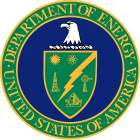Nevada Test Site
| Nevada Test Site | |
|---|---|
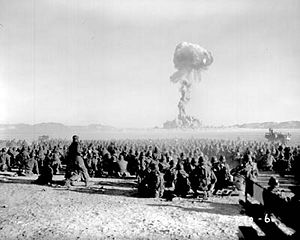 November 1951 nuclear test at Nevada Test Site. Test is shot "Dog" from Operation Buster, with a yield of 21 kilotons. It was the first U.S. nuclear field exercise conducted on land; troops shown are 6 mi (9.7 km) from the blast. |
|
| Type | Nuclear testing range |
| Location | near Las Vegas in the United States |
| Area | ~1,350 sq mi (3,500 km2) |
| Operator | United States Department of Energy |
| Status | Active |
| In use | 1951–present |
| Testing | |
| Nuclear tests |
928 |
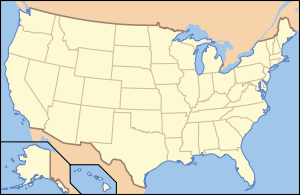 Map showing location of the site |
|
The Nevada National Security Site[1] (N2S2), previously the Nevada Test Site (NTS), is a United States Department of Energy reservation located in southeastern Nye County, Nevada, about 65 mi (105 km) northwest of the city of Las Vegas. Formerly known as the Nevada Proving Grounds,[2] the site, established on 11 January 1951, for the testing of nuclear devices, is composed of approximately 1,360 sq mi (3,500 km2) of desert and mountainous terrain. Nuclear testing at the Nevada Test Site began with a one-kiloton (4 terajoule) bomb dropped on Frenchman Flat on 27 January 1951. Many of the iconic images of the nuclear era come from NTS.
The Nevada Test Site contains 28 areas, 1,100 buildings, 400 miles (640 km) of paved roads, 300 miles (480 km) of unpaved roads, 10 heliports and two airstrips.
History
Established as a 680-square-mile (1,800 km2) area by president Harry Truman on December 18, 1950 within the Nellis Air Force Gunnery and Bombing Range[2]
1951–1992
Between 1951 and 1992, there were a total of 928 announced nuclear tests at Nevada Test Site. Of those, 828 were underground.[3] (Sixty-two of the underground tests included multiple, simultaneous nuclear detonations, adding 93 detonations and bringing the total number of NTS nuclear detonations to 1,021, of which 921 were underground.)[4] The site is covered with subsidence craters from the testing. The Nevada Test Site was the primary testing location of American nuclear devices; 126 tests were conducted elsewhere (many at the Pacific Proving Grounds in the Marshall Islands).
During the 1950s, the mushroom cloud from these tests could be seen for almost 100 mi (160 km) in either direction, including the city of Las Vegas, where the tests became tourist attractions. Americans headed for Las Vegas to witness the distant mushroom clouds that could be seen from the downtown hotels.
On 17 July 1962, the test shot "Little Feller I" of Operation Sunbeam became the last atmospheric test detonation at the Nevada Test Site. Underground testing of weapons continued until 23 September 1992, and although the United States did not ratify the Comprehensive Test Ban Treaty, the articles of the treaty are nevertheless honored and further tests have not occurred. Subcritical testing, tests not involving the full creation of a critical mass, continue.
One notable test shot was the "Sedan" shot of Operation Storax on 6 July 1962, a 104 kiloton shot for the Operation Plowshare which sought to prove that nuclear weapons could be used for peaceful means in creating bays or canals—it created a crater 1,280 feet (390 m) wide and 320 feet (100 m) deep that can still be seen today. While most of the larger tests were conducted elsewhere, NTS was home to tests in the 500 kiloton to 1 megaton (2 to 4 petajoule) range, which caused noticeable seismic effects in Las Vegas.
1992–2007
The site was scheduled to be used to conduct the testing of a 1,100-ton conventional explosive in an operation known as Divine Strake in June 2006. The bomb is a possible alternative to nuclear bunker busters.[5] However, after objection from Nevada and Utah members of Congress, the operation was postponed until 2007. On 22 February 2007 the Defense Threat Reduction Agency (DTRA) officially canceled the experiment.
Destruction and Survivability testing
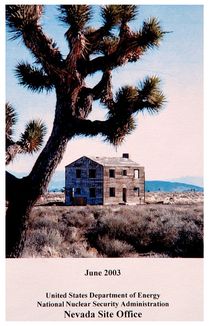
NTS also performed "piggyback" testing of effects of nuclear detonation during the above-ground tests. Vehicles, shelters, utility stations, and other structures were placed at various distances from the "Ground Zero" detonation point of each weapon.
Homes and commercial buildings were built to standards typical of American and European cities. Other structures included military fortifications (of types used by both NATO and the Warsaw Pact), civil defense, and "backyard" shelters. In a typical test several buildings might be built using the same plan with different types of paint, landscaping, cleanliness of yards, wall angles, or distances from Ground Zero. Mannequins were placed in and around vehicles and buildings.
High-speed cameras were placed in protected locations to capture effects of radiation and shock waves. Typical imagery from these cameras shows paint boiling off of the buildings, which then are pushed away from Ground Zero by the shock wave before being drawn toward the detonation by the suction caused by the climbing mushroom cloud.
This testing allowed the development of guidelines, distributed to the public, to increase the likelihood of survival in case of air- or spaceborne nuclear attack.
Environmental impact
Each of the underground explosions—some as deep as 5,000 feet—vaporized a large chamber, leaving a cavity filled with radioactive rubble. About a third of the tests were conducted directly in aquifers, and others were hundreds or thousands of feet above the water table.[6]
When testing ended in 1992, the Energy Department estimated that more than 300 million curies of radiation remained, making the site one of the most radioactively contaminated places in the United States. In the worst affected zones, radioactivity in the tainted water reaches millions of picocuries per liter. (The federal standard for drinking water is 20 picocuries per liter.) Although radiation levels in the water have declined over time, the longer-lived isotopes will continue to pose risks for tens of thousands of years.[6]
The Energy Department has 48 monitoring wells at the site and recently began drilling nine deep wells. Because the contaminated water poses no immediate health threat, the Department has ranked Nevada as a low priority for cleaning up major nuclear weapons sites, and it operates far fewer wells than at most other contaminated sites.[6]
Protests and demonstrations
From 1986 through 1994, two years after the United States put a hold on full-scale nuclear weapons testing, 536 demonstrations were held at the Nevada Test Site involving 37,488 participants and 15,740 arrests, according to government records.[7]
American Peace Test (APT) and Nevada Desert Experience (NDE) held most of these.[8] In March 1988, APT held an event where more than 8,000 people attended a ten-day action to "Reclaim the Test Site", where nearly 3,000 people were arrested with more than 1,200 in one day. This set a record for most civil disobedience arrests in a single protest. American Peace Test was collectively run by a group of individuals residing in Las Vegas, but leadership for the group was national. It originated with a small group of people who were active in the National Nuclear Weapons Freeze. APT was a breakaway organization beginning in 1986, with first public events held in 1987.
In the years that followed 1994, Shundahai Network in cooperation with Nevada Desert Experience and Corbin Harney continued the protests of the government's continued nuclear weapons work and also staged efforts to stop a repository for highly radioactive waste adjacent to the test site at Yucca Mountain, 100 mi (160 km) northwest of Las Vegas.
NTS today
The test site offers monthly public tours, often fully booked months in advance. Visitors are not allowed to bring in cameras, binoculars, cell phones, or pick up rocks for souvenirs.[9]
While there are no longer any explosive tests of nuclear weapons at the site, there is still subcritical testing, used to determine the viability of the United States' aging nuclear arsenal. Additionally, the site is the location of the Area 5 Radioactive Waste Management Complex, which sorts and stores low-level radioactive waste that is not transuranic and has a half life not longer than 20 years. Bechtel Nevada Corporation (a joint venture of Lockheed Martin, Bechtel and Johnson Controls) ran this complex until 2006. Several other companies won the latest bid for the contract. They then combined to form a new company called National Security Technologies, LLC (a joint venture of Northrop Grumman, AECOM, CH2M Hill and Nuclear Fuel Services[10]). AECOM, known earlier as Holmes and Narver, held the Nevada Test Site contract for many years before Bechtel Nevada Corp. had it.
Located at the ground zero for the Operation Teapot nuclear test is the Transportation Incident Exercise Site, which replicates multiple terrorist radiological incidents with train, plane, automobile, truck, and helicopter props.
Landmarks and geography
The town of Mercury, Nevada, is located on the grounds of the NTS, and at one time housed contingents from Los Alamos National Laboratory, Lawrence Livermore National Laboratory, and Sandia National Laboratories. Area 51 is north of NTS and the proposed high-level nuclear waste storage facility at Yucca Mountain is at the southwest corner. The BREN Tower, a 1,527 ft (465 m)-high tower is located in the NTS at Jackass Flats.
Cancer and test site
A 1979 study reported in the New England Journal of Medicine concluded that:
A significant excess of leukemia deaths occurred in children up to 14 years of age living in Utah between 1959 and 1967. This excess was concentrated in the cohort of children born between 1951 and 1958, and was most pronounced in those residing in counties receiving high fallout.[11]
In 1982, a lawsuit brought by nearly 1,200 people accused the government of negligence in atomic and/or nuclear weapons testing at the Nevada Test Site in the 1950s, which they said had caused leukemia and other cancers. Dr. Karl Z. Morgan testified that radiation protection measures in the tests were substandard.[12]
In a report by the National Cancer Institute, released in 1997, it was determined that ninety atmospheric tests at the Nevada Test Site (NTS) deposited high levels of radioactive iodine-131 (5.5 exabecquerels) across a large portion of the contiguous United States, especially in the years 1952, 1953, 1955, and 1957—doses large enough, they determined, to produce 10,000 to 75,000 cases of thyroid cancer. The Radiation Exposure Compensation Act of 1990 allowed for people living downwind of NTS for at least two years in particular Nevada, Arizona or Utah counties, between 21 January 1951 and 31 October 1958, or 30 June and 31 July 1962, and suffering from certain cancers or other serious illnesses deemed to have been caused by fallout exposure to receive compensation of $50,000. By January 2006, over 10,500 claims had been approved, and around 3,000 denied, for a total amount of over $525 million in compensation dispensed to "downwinders".[13] Additionally, the Energy Employees Occupational Illness Compensation Program Act of 2000 provides compensation and medical benefits for nuclear weapons workers who may have developed certain work-related illnesses.[14]
Uranium miners, mill workers, and ore transporters are also eligible for $100,000 compassionate payment under the Radiation Exposure Compensation Program, while $75,000 is the fixed payment amount for workers who were participants in the above-ground nuclear weapons tests.
Nuclear test series carried out at the Nevada Test Site
|
|
Areas

The Test Site is broken down into areas. Some of the areas and their uses include the following:
Area 1
Four early atmospheric tests were conducted above Area 1 in the early 1950s, as well as three underground tests in 1971 and 1990. In 1955, a Civil Defense experiment (called Operation Cue in the press) studied nuclear blast effects on various building types; a few structures still stand.
Heavy drilling equipment and concrete construction facilities are sited in Area 1. Non-destructive X-ray, gamma ray, and subcritical detonation tests continue to be conducted in Area 1.
The radioactivity present on the ground in Area 1 provides a radiologically-contaminated environment for the training of first responders.[16]
Shot "Icecap" planned for 1993 was abandoned in Area 1 following 1992's testing moratorium. The tower, shaft and wiring remain in place, along with a crane intended to lower the nuclear test package into the shaft.[17]
Area 2
Area 2 witnessed 144 nuclear tests involving 169 explosions. Shot "Gabbs" intended for 1993 was abandoned in place in Area 2.[17]
Area 3
Area 3 held 266 nuclear tests with 288 detonations—the largest number of any NTS test area.
As part of Operation Tinderbox, on 24 June 1980, a small satellite prototype (DSCS III) was subjected to radioactivity from the "Huron King" shot in a vertical line-of-sight (VLOS) test undertaken in Area 3. This was a program to improve the database on nuclear hardening design techniques for defense satellites.
The final nuclear test detonation at Nevada Test Site was Operation Julin's "Divider" on 23 September 1992, just prior to the moratorium temporarily ending all nuclear testing. Divider was a safety experiment test shot that was detonated at the bottom of a shaft sunk into Area 3.
In 1995 and 1997, plutonium-contaminated soil from "Double Tracks" and "Clean Slate 1" of Operation Roller Coaster (1963) was picked up from the Tonopah Test Range and brought to the Area 3 Radioactive Waste Management Site as a first step in eventually returning Tonopah Test Range to an environmentally neutral state. Corrective action regarding the contaminated material from the "Clean Slate 2" and "Clean Slate 3" tests has yet to be agreed upon.[18]
Area 4
Area 4 was the site of 40 nuclear tests with 44 detonations.
Area 5
Five atmospheric tests were detonated, starting on 27 January 1951 at Area 5 as part of Operation Ranger. These were the first nuclear tests at NTS. Further tower detonations were studied at Area 5, and the "Grable" shot which was fired from an artillery piece located in Area 11 exploded in Area 5. The Priscilla test was conducted at Area 5 on 24 June 1957.
Five underground tests were setup at Area 5; four of those suffered accidental release of radioactive materials. On 16 March 1968, physicist Glenn T. Seaborg toured the upcoming "Milk Shake" shot of Operation Crosstie.[19] Milk Shake's radioactive release was not detected outside of NTS boundaries.
A total of 19 nuclear test detonations took place in Area 5.
Area 6
Four nuclear tests were conducted at Area 6, comprising six detonations.
Area 7
Area 7 had 92 test explosions.
During Operation Buster, four successful tests were conducted via airdrop, with bomber aircraft releasing nuclear weapons over Area 7.
Area 8
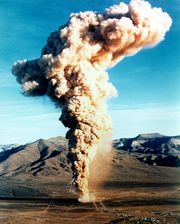
Thirteen nuclear tests happened at Area 8; 15 detonations in all.
Area 8 hosted the "Baneberry" shot of Operation Emery on 18 December 1970. The Baneberry 10 kiloton test detonated 900 feet below the surface but its energy cracked the soil in unexpected ways, causing a fissure near ground zero and the failure of the shaft stemming and cap.[20] A plume of fire and dust was released, raining fallout on workers in different locations within NTS. The radioactive plume released 6.7 million Curies of radioactive material, including 80 kCi of 131I.[21]
Area 9
Area 9 saw 115 nuclear test events incorporating 133 detonations.
In Area 9, the 74-kiloton "Hood" test on 5 July 1957, part of Operation Plumbbob, was the largest atmospheric test ever conducted within the continental United States; nearly five times larger in yield than the bomb dropped on Hiroshima. A balloon carried Hood up to 460 meters above the ground where it was detonated. Over 2,000 troops took part in the test in order to train them in conducting operations on the nuclear battlefield. 11 million Curies of Iodine-131 (131I) were released into the air.[21]
Area 10
Nuclear tests at Area 10 detonated 71 devices during 57 shots.
The first underground test at NTS was the "Uncle" shot of Operation Jangle. Uncle detonated on 29 November 1951 within a shaft sunk into Area 10.
The "John" shot of Plumbbob, on 19 July 1957, was the first test firing of the nuclear-tipped AIR-2 Genie air-to-air rocket designed to destroy incoming enemy bombers with a nuclear explosion. The two-kiloton warhead exploded approximately three miles above five volunteers and a photographer who stood unprotected at "ground zero" in Area 10 to show the apparent safety of battlefield nuclear weapons to personnel on the ground.[22] The test also demonstrated the ability of a fighter aircraft to deliver a nuclear-tipped rocket and avoid being destroyed in the process. A Northrop F-89J fired the rocket.
The "Sedan" test of Operation Storax on 6 July 1962, a 104 kiloton shot for the Operation Plowshare which sought to discover whether nuclear weapons could be used for peaceful means in creating lakes, bays or canals. The explosion displaced twelve million tons of earth, creating the Sedan crater which is 1,280 feet (390 m) wide and 320 feet (100 m) deep.
Area 11
Nine test detonations were carried out at Area 11. Four of the tests were weapons safety experiments conducted as Project 56; they spread so much harmful radioactive material around the test sites that Area 11 has been called "Plutonium Valley". As is the case with Area 1, background radiation levels make Area 11 suitable for realistic training in methods of radiation detection.[18]
Area 12
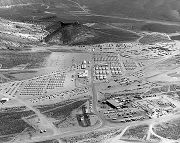
The Rainier Mesa and Aqueduct Mesas within Area 12 held 61 nuclear tests, one of which involved two detonations.
At 7,675 feet, the top of Rainier Mesa is the highest elevation within NTS. As of 2008, Area 12 was being used by the Office of Secure Transportation as a secure training facility.[23]
Area 13
There is no Area 13 within NTS, though such a name is attached to a section of Nellis Air Force Range which abuts the northeastern corner of Area 15.[24] Project 57's weapons safety test was conducted here on 24 April 1957, spreading particles emitting alpha radiation over a large area. In 1981, the hundreds of thousands of cubic yards of contaminated soil of Area 13 were carried into NTS and stored at a waste facility. A 1998 reassessment of Area 13 found that buried metal debris exists in a landfill onsite. Data regarding Area 13's fate are still under review.[18]
Area 14
This geologically isolated area has not been the site of nuclear detonation tests. Non-nuclear tests have taken place in Area 14, and MX missile deployment shelters have been assessed.
Area 15
The old, abandoned Crystal and Climax mines are found at Area 15. Three underground detonations took place in the area in the mid-1960s. Storage tanks hold contaminated materials, and two test sites remain in the area. The Hardhat-Piledriver site has a massive underground installation: "Piledriver" was an expensive Department of Defense test studying the survivability of hardened underground bunkers undergoing a nuclear attack.
From 1964 to 1984, the Environmental Protection Agency operated a research farm in Area 15, including a 30-acre dairy farm and a herd of pigs.
Area 16
Area 16 hosted at least 4 detonations.[15]
Area 17
This area was not used for any detonations.[15]
Area 18
Area 18 hosted at least 2 detonations and includes the Pahute Airstrip.[15]
Area 19
Area 19 was the site of 36 tests, including high yield ones greater than one megaton in size. Tests were conducted at Area 19 from 1966 to 1992.
Shot "Greenwater" awaits its fate in Area 19. Preparations for it lay abandoned until a decision is made.[17]
Area 20
Area 20 was used for 49 nuclear tests, beginning in 1965 with "Palanquin", a part of Operation Whetstone. The final test was "Montello", a treaty verification test, in 1991, part of Operation Sculpin.[3]
Area 22
Area 22 once held Camp Desert Rock, a staging base for troops undergoing atmospheric nuclear blast training; as many as 9,000 troops were camped there in 1955. Desert Rock Airport was enlarged to 7500 ft. length in 1969 by the Atomic Energy Commission. It is a transport hub for personnel and supplies going to NTS and also serves as an emergency landing strip.
Area 23
The town of Mercury, Nevada lies within Area 23. The area is the main pathway to and from NTS test locations by way of U.S. Route 95. An open sanitary landfill is located to the west of Mercury, and a closed hazardous waste site abuts the landfill.
Area 25
Area 25 is the largest section of NTS, and has its own direct access from Route 95. The majority of Area 25 is composed of a shallow alluvial basin called Jackass Flats. No nuclear explosions have occurred within Area 25. Non-explosive nuclear tests were carried out at various sites: Project Pluto was tasked with engineering a nuclear ramjet engine, and Project Orion designed a nuclear rocket engine at the Nuclear Rocket Development Station (NRDS). Both projects were successful, but other technologies were selected instead. On 8 December 1962, President John F. Kennedy came to Area 25 to gauge the progress of the nuclear rocket engine program.[19]
The Rock Valley Study Area, at the southern boundary of Area 25, was used for studies of radiation in a desert ecosystem, starting in 1960.
High-level radioactive materials handling studies were carried out at the Engine Maintenance Assembly and Disassembly (E-MAD) building.
The BREN Tower currently stands within Jackass Flats, where it was moved after 1963 for the High Energy Neutron Reaction Experiment (HENRE) series.
A "Treatability Test Facility" was established in Area 25 to study the physics of decontaminating soil containing plutonium or uranium.
Yucca Mountain nuclear waste repository studies are being conducted at the site of earlier NRDS work. Yucca Mountain extends into Area 25.
Area 26
Area 26 is the most arid section of NTS. An old abandoned mine, the Horn Silver Mine, was used for waste disposal between 1959 and the 1970s; some of the waste is radioactive. Water flow past the shaft could pose a human health risk, so corrective action has been planned.[25]
In Area 26, there were some tests related to Project Pluto; those buildings have been used recently as mock reactor facilities in the training of first responders. No nuclear explosions were ever generated at Area 26.
Area 27
No nuclear detonations have occurred at Area 27. The section contains underground storage bunkers as well as assembly bays and lab space. The Super Kukla Reactor Facility was built in Area 27; it's now entombed in place.[26]
The Joint Actinide Shock Physics Experimental Research (JASPER) facility was installed in Area 27, beginning in April 1999 when a former weapons assembly complex was decommissioned and repurposed to house the JASPER two-stage high-energy shock gun. By September 1999, facility modifications were finished,[27] and in April 2003, all qualification testing using non-nuclear materials was complete.[28] By May 2007, a series of tests comparing new plutonium weapons pits with old ones had confirmed that the plutonium cores in US weapons stockpiles were less subject to deleterious aging effects than previously anticipated.[29]
Area 28
Area 28 no longer exists; it was absorbed into Areas 25 and 27.
Area 29
The rugged terrain of Area 29 serves as a buffer between other areas of NTS. A helipad is present at Shoshone Peak.
Area 30
The town of Mercury, Nevada is located on the grounds of the NTS, and at one time housed contingents from Los Alamos National Laboratory, Lawrence Livermore National Laboratory, and Sandia National Laboratories. Area 51 and the proposed high-level nuclear waste storage facility at Yucca Mountain are located nearby. The BREN Tower, a 1,527-foot (465 m) high guyed tower originally for radiation experiments with an unshielded reactor simulating the amounts of radiation received by survivors from Hiroshima and Nagasaki, is located in the NTS at Jackass Flats.
Gallery
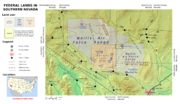 Map showing the NTS and other federal territories in southern Nevada |
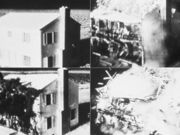 Frame House destroyed by nuclear blast on 17 March 1953, Annie shot of Operation Upshot- Knothole, 16 kilotons. Overpressure at house location 5 psi. |
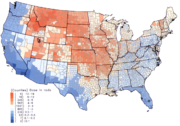 Per capita thyroid doses in the continental United States of Iodine-131 resulting from all exposure routes from all atmospheric nuclear tests conducted at the Nevada Test Site |
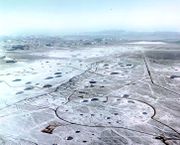 The Yucca Flat area of the Nevada Test Site is scarred with subsidence craters from underground nuclear testing |
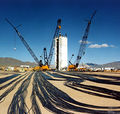 Preparing for an underground test. The emplacement tower lowers the nuclear device into the drilled shaft; the cables run to instruments that record information from the experiment |
 Detonated on 5 July 1957, the "Hood" event of Operation Plumbbob was the largest atmospheric nuclear test to occur on the continent, with a yield of 74 kilotons. It was later revealed by the AEC, that Hood was in fact a thermonuclear test, not a fission device as had been originally stated. |
 Hood's radioactive cloud tops off at nearly 49,000 feet above Yucca flats, as seen from 14 miles away. The detonation sent an above normal thermal pulse across the desert, igniting bushes and other growth up to 3 miles away on nearby foothills, as seen to the right of the dust cloud on the desert floor. |
 Shot "Whitney" 19 kilotons, the 21st full scale nuclear test of Operation Plumbbob 1957. The fireball can be seen glowing at the top due to the ionization and cooling of radioactive isotopes at high altitude. |
 Shot "Priscilla" 37 kilotons. The 5th detonation and 3rd largest test of the Plumbbob series. Over 700 pigs where incorporated in various nuclear effects studies during the test. The blast was felt strongly and heard as a sharp bang at the control point 14 miles away, shattering windows and blowing swinging door from hinges. |
 Fireball from the MET tower shot of Operation Teapot, 22 kilotons. |
 Operation Teapot - Wasp |
 Another view of the Wasp shot |
 Operation Teapot - Moth |
 Operation Teapot - Tesla.jpg |
 Another view of the Tesla shot |
 Operation Teapot - Turk |
 Operation Teapot - Bee |
 Operation Teapot - Ess |
 Another view of the Ess shot |
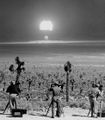 Operation Teapot - Wasp Prime |
 Operation Teapot - HA |
 Teapot MET (Military Effects Test), 22 kilotons |
.jpg) Another view of the MET shot. |
 Operation Teapot - Apple-2 |
 The 28 kiloton 15 May 1955 nuclear detonation at Nevada Test Site, final test of the Operation Teapot series. Code named Zucchini. |
 Operation Tumbler-Snapper, shot Dog, 19 kilotons, 25 May 1952. |
 One of the 500 foot towers being used |
 The remains of the tower after the explosion of the Bee device |
See also
- Alvin C. Graves
- Amchitka
- Atomic Testing Museum
- Corbin Harney
- Lookout Mountain Air Force Station
- Nevada Desert Experience
- Nevada Test and Training Range
References
- ↑ "Nevada nuclear bomb site given new name". United Press International. August 23. 2010. http://www.upi.com/Top_News/US/2010/08/23/Nevada-nuclear-bomb-site-given-new-name/UPI-39551282594195/. Retrieved 2010-08-23.
- ↑ 2.0 2.1 "Miss Atom Bomb". National Nuclear Security Administration. http://www.nv.doe.gov/library/factsheets/DOENV_1024.pdf. Retrieved 2010-06-14.
- ↑ 3.0 3.1 United States Nuclear Tests; July 1945 through September 1992, DOE/NV--209-REV 15 December 2000, p. xv.[1]
- ↑ One multiple test took place in Colorado; the other 62 were at NTS
- ↑ "Pentagon to Test a Huge Conventional Bomb". The Washington Post. 31 March 2006. http://www.washingtonpost.com/wp-dyn/content/article/2006/03/30/AR2006033001735.html. Retrieved 20 May 2010.
- ↑ 6.0 6.1 6.2 Ralph Vartabedian. Nuclear scars: Tainted water runs beneath Nevada desert Los Angeles Times, 13 November 2009.
- ↑ Western Shoshone spiritual leader dies
- ↑ Political protest and cultural revolution By Barbara Epstein p. 165.
- ↑ U.S. DOE/NNSA - Nevada Site Office, Nevada Test Site Tours http://www.nv.doe.gov/nts/nts.aspx
- ↑ National Security Technologies "About" Page http://www.nstec.com/about.htm
- ↑ Gerald H. Clarfield and William M. Wiecek (1984). Nuclear America: Military and Civilian Nuclear Power in the United States 1940-1980, Harper & Row, New York, p. 215.
- ↑ Karl Z. Morgan, 91, Founder of the Field Of Health Physics, Dies in Tennessee
- ↑ Radiation Exposure Compensation System: Claims to Date Summary of Claims Received by 06/11/2009
- ↑ Office of Compensation Analysis and Support. National Institute for Occupational Safety and Health.
- ↑ 15.0 15.1 15.2 15.3 United States Geologic Survey. Nevada Test Site. Geologic Surface Effects of Underground Nuclear Testing. Accessed on 18 April 2009.
- ↑ US Department of Energy. Nevada Operations Office. National Security. Homeland Security. First Responder Training
- ↑ 17.0 17.1 17.2 US Department of Energy. Nevada Operations Office. Library. Factsheets. Icecap (May 2007)
- ↑ 18.0 18.1 18.2 US Department of Energy. Nevada Operations Office. Library. Factsheets. Plutonium Dispersal Tests at the Nevada Test Site (April 2005)
- ↑ 19.0 19.1 Radiochemistry.org. History. Nuke tests. Nevada Test Site Images (cdrom 3)
- ↑ Lawrence Livermore National Laboratory. News Archive. Tarabay H. Antoun. Three Dimensional Simulation of the Baneberry Nuclear Event
- ↑ 21.0 21.1 National Cancer Institute. National Institute of Health. History of the Nevada Test Site and Nuclear Testing Background
- ↑ California Literary Review. Peter Kuran. Images from How To Photograph an Atomic Bomb. (22 October 2007)
- ↑ Knapp, George (2008-11-07). "I-Team: The Road Warriors, Part 2". http://www.lasvegasnow.com/global/story.asp?s=9315164. Retrieved 2008-11-10.
- ↑ Nevada Division of Environmental Protection. Bureau of Federal Facilities. Federal Facility Agreement & Consent Order. FFACO Description of Facilities
- ↑ DOE Scientific and Technical Information. Corrective Action Investigation Plan for Corrective Action Unit 527: Horn Silver Mine, Nevada Test Site, Nevada: Revision 1 (Including Records of Technical Change No.1, 2, 3, and 4) (6 December 2002) DOI:10.2172/818649
- ↑ Las Vegas Review-Journal. 16 February 2008. Keith Rogers. U.S. NUCLEAR WEAPONS DEVELOPMENT: Test site profile revamped: Little-known Super Kukla delineated
- ↑ Plan of Action: JASPER Management Prestart Review (Surrogate Material Experiments). W. E. Cooper. 23 October 2000. Lawrence Livermore National Laboratory. U.S. Department of Energy.
- ↑ LLNL. Science & Technology Review, June 2004. Shocking Plutonium to Reveal Its Secrets
- ↑ LLNL. Science & Technology Review, May 2007. U.S. Weapons Plutonium Aging Gracefully
External links
- DOE Nevada Test Site
- The Nevada Test Site Oral History Project
- Origins of the Nevada Test Site
- Radiation Exposure Compensation Act
- Account of NTS fallout in 1955 (PDF)
- Study Estimating Thyroid Doses of I-131 Received by Americans From Nevada Atmospheric Nuclear Bomb Test, National Cancer Institute (1997)
- Images of the Nevada Test Site on the atomic bomb website
- Location maps:
- Annotated bibliography for the Nevada Test Site from the Alsos Digital Library for Nuclear Issues
- 'Exposed' spreads anti-nuke message
|
||||||||||||||||||||||||||||||||
|
||||||||||||||||
